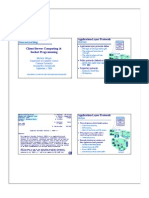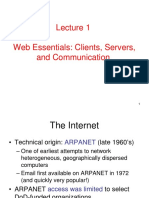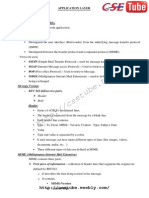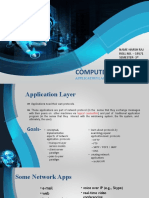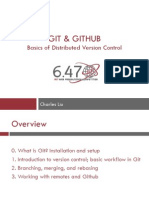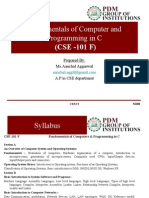Application Layer Protocols
Networked Systems 3
Lecture 17
�Lecture Outline
• Application logic and protocol style
• How is the application protocol data structured?
• How do the interactions occur?
• How are errors signalled?
• Application protocol examples
• SMTP, POP3, HTTP, Jabber
2
�Application Logic
• Session layer conveys data between applications
• The presentation and application layers impose
meaning on that data to perform an application-
level task
• Deliver email
• Retrieve web pages
• Stream video
• Etc.
3
�Protocol Style
• How is the application protocol data structured?
• Textual or binary?
• Framing mechanism?
• How do the interactions occur?
• Explicit request-response, or potentially unsolicited?
• Degree of chatter?
• How are errors reported?
4
�Textual or Binary?
• Does the protocol exchange textual or binary
messages?
• Textual – flexible and extensible
• See http://www.ietf.org/rfc/rfc3252.txt – “Binary Lexical Octet Ad-hoc
Transport” – for a counter example (and note the publication date!)
• High-level application layer protocols (e.g. email, web, instant
messaging, …)
• Binary – highly optimised and efficient
• Audio and video data (e.g. JPEG, MPEG, Vorbis, …)
• Low-level or multimedia transport protocols (e.g. TCP/IP, RTP, …)
5
�Framing over TCP
• How to denote record boundaries?
• TCP connection is reliable, but doesn’t frame the data; must parse the
byte stream
• Requires a structured protocol:
• HTTP/RTSP/SIP – text based messages, comprising an initial request,
followed by headers, one per line, ending with a blank line
• XML-based protocols (e.g. Jabber) – parse data until the appropriate
closing tag is seen
• Binary protocols – begin with a length field, telling how much data to
read
6
�Framing over UDP
• UDP provides framing – data is delivered a packet
at a time – but is unreliable
• Application must organise the data so it’s useful if
some packets lost
• E.g. streaming video with I and P frames
Intermediate (predicted) frames Full frame
Time
7
�How do Interactions Occur?
• How does communication proceed?
• Does the server announce its presence on the initial connection? Or does
it wait for the client to start?
• Is there an explicit request for every response? Can the server send
unsolicited data?
• Is there a lot of chatter, or does the communication complete within a
single round-trip?
8
�Reducing Protocol Chatter
• The more “chatty” protocols take many round trips
to complete a transaction
• RTT fixed by speed-of-light irrespective of network bandwidth → often
limiting factor in response time
• Want to reduce number of round trips before the
transaction completes → send transaction in single
request, get a single response
9
�How are Responses Signalled?
• Useful to have an extensible framework for
response codes
Error Code Meaning
• Many applications settled on a 1xx In progress
three digit numeric code 2xx Ok
3xx Redirect
• First digit indicates response type
4xx Client error
• Last two digits give specific error
5xx Server error
(or other response)
10
�Application Protocol Examples
• Wide range of application protocols used today
• Four common examples:
• SMTP – sending email
• POP3 – retrieving email
• HTTP – world wide web
• Jabber – open standard for instant messaging
11
�Email
• One of the oldest Internet applications
• Simple Mail Transfer Protocol (SMTP)
• http://www.ietf.org/rfc/rfc5321.txt Mail sending
Original version: RFCs 821 and 822
• http://www.ietf.org/rfc/rfc5322.txt
• Post Office Protocol, v3
Mail download from server
• http://www.ietf.org/rfc/rfc1939.txt
• Internet Message Access Protocol, v4rev1
Remote mailbox manipulation
• http://www.ietf.org/rfc/rfc3501.txt
12
�Sending Email: SMTP
S: 220 mr1.dcs.gla.ac.uk ESMTP Exim 4.42 Wed, 27 Feb 2008 10:31:18 +0000
C: HELO bo720-1-01.dcs.gla.ac.uk
S: 250 mr1.dcs.gla.ac.uk Hello bo720-1-01.dcs.gla.ac.uk [130.209.250.151]
C: MAIL FROM:csp@dcs.gla.ac.uk
S: 250 OK Line-by-line request-response; very chatty
C: RCPT TO:csp@csperkins.org All commands are four characters + data
S: 250 Accepted All responses are numeric + explanatory text
C: DATA
S: 354 Enter message, ending with "." on a line by itself
C: From: Colin Perkins <csp@dcs.gla.ac.uk>
C: To: Colin Perkins <csp@csperkins.org>
C: Date: Wed 27 Feb 2008 10:32:45
C: Subject: Test
C: Structure of message: inspiration for HTTP design
C: This is a test Headers, blank line, then body
C: . Many headers re-used identically in HTTP
S: 250 OK id=1JUJa1-00073j-22
C: QUIT
S: 221 mr1.dcs.gla.ac.uk closing connection
13
�Retrieving Email: POP3
S: +OK POP3 mr1 v2003.83rh server ready
C: USER csp
S: +OK User name accepted, password please
C: PASS ...password elided...
S: +OK Mailbox open, 4 messages
C: STAT
S: +OK 4 21142
C: LIST
S: +OK Mailbox scan listing follows
S: 1 1626 Line-by-line request-response; very chatty
S: 2 7384 Follows style of SMTP
S: 3 6101
S: 4 6031
S: .
C: RETR 1
S: +OK 1626 octets
S: Return-path: <jcz@vxu.se>
S: Envelope-to: csp@dcs.gla.ac.uk
S: Delivery-date: Wed, 13 Feb 2008 18:40:07 +0000
S: ...email message elided...
S: .
C: DELE 1
S: +OK Message deleted
C: QUIT
S: +OK Sayonara
14
�World Wide Web: HTTP
• Hypertext Transport Protocol – HTTP/1.1
• http://www.ietf.org/rfc/rfc2616.txt
• Flexible, textual, client-server protocol, with no
unsolicited responses
• Range of request types (GET, PUT, OPTIONS, …)
• Extremely flexible headers → hard to parse, validate
• All information needed to answer a request sent at once – response can
be provided within single RTT
15
�World Wide Web: HTTP
C: GET /index.html HTTP/1.1 Initial request line (“GET…”)
C: Accept-Language: en-gb Headers, one per line
C: Accept-Encoding: gzip, deflate Blank line indicates end of request
C: Accept: text/xml, application/xml, application/xhtml+xml, text/html, text/plain
C: User-Agent: Mozilla/5.0 (Macintosh; U; PPC Mac OS X; en-gb)
C: AppleWebKit/523.12.2 (KHTML, like Gecko) Version/3.0.4 Safari/523.12.2
C: Cache-Control: max-age=0
C: Connection: keep-alive
C: Host: www.dcs.gla.ac.uk
C:
Initial response code (“HTTP/1.1 200 OK”)
S: HTTP/1.1 200 OK
Headers, one per line
S: Date: Wed, 27 Feb 2008 22:44:25 GMT
The “Content-Length:” header indicates body
S: Server: Apache/2.0.46 (Red Hat)
size
S: Last-Modified: Mon, 17 Nov 2003 08:06:50 GMT Blank line indicates end of headers
S: Accept-Ranges: bytes
S: Content-Length: 3646 Unstructured body data follows, with specified
S: Connection: close size
S: Content-Type: text/html; charset=UTF-8
S:
S: <HTML>
S: <HEAD>
S: <TITLE>Computing Science, University of Glasgow</TITLE>
S: ...remainder of page elided...
16
�Instant Messaging
• Many proprietary instant messaging protocols
• MSN, AIM, etc.
• Poorly documented, trying to achieve lock-in
• Two open standards
• Extensible Messaging and Presence Protocol (XMPP)
• http://www.ietf.org/rfc/rfc3920.txt (a.k.a. “Jabber”)
• SIP for Instant Messaging and Presence Leveraging Extensions
(SIMPLE)
• Extremely complex; driven by telcos; not widely used
17
�Instant Messaging: Jabber
C: <?xml version='1.0'?>
<stream:stream to='example.com' xmlns='jabber:client'
xmlns:stream='http://etherx.jabber.org/streams' version='1.0'>
S: <?xml version='1.0'?>
<stream:stream from='example.com' id='someid'
xmlns='jabber:client'
xmlns:stream='http://etherx.jabber.org/streams' version='1.0'>
C: <message from='juliet@example.com' to='romeo@example.net'
xml:lang='en'>
C: <body>Art thou not Romeo, and a Montague?</body>
C: </message>
S: <message from='romeo@example.net' to='juliet@example.com'
xml:lang='en'>
Source: RFC 3920
S: <body>Neither, fair saint, if either thee dislike.</body>
S: </message>
Data structured as an XML stream
C: </stream:stream>
Must be incrementally parsed, watching for closing tags
S: </stream:stream>
Easy to validate correctness, due to formal XML syntax
Inefficient, due to XML bloat → compresses well
Lots of open source tools: www.jabber.org
18
�Application Protocol Examples
• Only given brief overview of these protocols –
many details omitted
• If implementing, read the standards documents, to understand the details!
• Internet applications traditionally built on very
flexible, text-based, protocols
• Open standards, open source, rapid evolution
19
�Questions?
20

